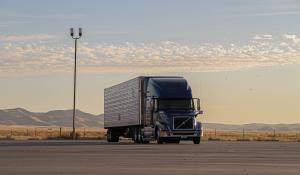
Tim Zang of Kansas City, Missouri, bought a diesel Jeep Liberty last year. When he drove off the lot, instead of heading to a fuel pump, he headed straight home, where a 55-gallon drum of Missouri-grown, 100-percent soy-based biodiesel sat waiting for him in his garage.
“Every gallon of soy we use replaces a gallon of fossil fuel,” says Zang. “The money I spend on soy stays right here in Missouri, biodiesel is better for my engine and better for the environment, and if we as a society wake up to the benefits of biofuels, they can put a lot of people to work here in the US.”
After using fuel from the drum in his garage for several months (sometimes mixing it with conventional diesel, which is necessary to keep biodiesel at temperatures below freezing), the Kansas City fuel market caught up to Zang, and in April the first public biodiesel fueling station opened a few miles from his home.
Zang switched back to fueling up at a pump, and other Kansas City residents, pinched by ever increasing petroleum costs, started giving biodiesel a chance as well.
“Biodiesel was an easy choice for us,” says James Brooks, vice president of the Kansas-City-based United Beverage Company, which switched its entire fleet to biodiesel in April. “We’re an urban wholesaler with lots of trucks on the streets of downtown. Using biodiesel is something we can do for ourselves and for the city.”
Furthermore, adds Zang, the last time he filled up from the public biodiesel pump, his cost was ten cents per gallon cheaper than if he had filled up with conventional diesel.
Why Biodiesel?
Studies show that biodiesel outperforms gasoline, ethanol, and conventional diesel in reducing climate-altering carbon dioxide emissions and in overall fuel-efficiency (see sidebars below).
Using 100-percent biodiesel (B100) eliminates all of the sulfur emissions associated with conventional diesel, cuts emissions of carbon monoxide and smog-producing particulate matter almost in half, and reduces hydrocarbon emissions by between 75 and 90 percent. Perhaps most significantly, using B100 reduces the emissions of carbon dioxide—the main greenhouse gas causing global warming—by more than 75 percent. Even using a blended biodiesel fuel like B20 (a 20-percent biodiesel/80-percent petrodiesel blend offered at most biodiesel fueling stations) still reduces carbon dioxide emissions by 15 percent, according to the Department of Energy.
Besides lowering emissions at the point of use, biodiesel fuel—made from corn, soy, or other plant matter—had a past life absorbing carbon dioxide while it was growing as a crop in the field. With its past carbon dioxide absorptions balancing its later carbon dioxide emissions, biodiesel results in an overall life-cycle lowering of carbon dioxide emissions over both conventional diesel and gasoline. The industrial processes used to produce biodiesel are cleaner than conventional diesel processes, reducing emissions associated with the life cycle of the fuel by more than 80 percent.
As a cleaner burning fuel, biodiesel is better for a car’s engine than conventional diesel, providing greater lubrication and leaving fewer particulate deposits behind. Biodiesel’s high ignition point (350°F vs. –43°F for gasoline) makes it a safer fuel as well. Biodiesel is biodegradable and considered nontoxic by the Environmental Protection Agency. All diesel vehicles have 20- to 30-percent higher fuel economies than comparable gasoline vehicles.
Biodiesel also frees car-drivers from reliance on dwindling fossil fuel resources and the world politics associated with obtaining those resources. It also keeps fuel dollars in the US. Biodiesel is more accessible than ever, with the number of public fueling stations in the United States rising from zero in 1997 to over 1000 today. To find a biodiesel fueling station or local biodiesel supplier near you, visit the National Biodiesel Board’s Web site.
Recycled Waste Oil as Fuel
Taking an even bigger step toward sustainability, some drivers bypass fueling at the pump or ordering a drum from a supplier and make their own biodiesel from the waste oil produced by local restaurants, converting what would have been garbage into a usable product.
Any organic oil you can find can be converted into fuel for a diesel vehicle through the use of a chemical catalyst and an alcohol—most commonly lye and methanol, which must be handled with care. The process of making your own fuel is not difficult, but is somewhat labor intensive and takes about a week from start to finish. You can find several biodiesel recipes online at Biodiesel Community, or by joining the forums at Biodiesel.org (Find supplies online from Green America's Green Business Network™ member Real Goods)
Other drivers choose to modify their diesel cars to accept straight vegetable oil (SVO), rather than modify the oil into a fuel. The quality and condition of the waste oil used as straight fuel matters more than the condition of waste oil converted into diesel fuel. Therefore, even if you modify your car, you still might need to spend time filtering and purifying your waste oil before you can pour it into your car’s tank. You can find more information about SVO and purchase conversion kits for your diesel car from Web sites like these: Golden Fuel Systems, Greasecar Vegetable Fuel Systems, and Neoteric Biofuels.
Biodiesel and the Future
In the long term, renewable energy experts differ on the upper limit of biodiesel’s possibilities as an industry, should biodiesel become wildly successful., adopted as America’s primary choice for fuel
With the country already consuming more than 40 billion gallons of diesel fuel every year, a massive shift to biodiesel would make impossible demands on our available agricultural land. Cornell ecology professor David Pimintel explained in a 2005 study how he had studied large-scale bio-fuel production based on corn, switchgrass, wood biomass, soy, and sunflowers, and found each to be unsustainable. Others argue that even if such land-use was a possibility, the resulting agricultural shift toward fuel farming would trigger unintended consequencs, such as spikes in the price of food crops. For example, in Europe, demand for biodiesel has triggered increasing imports of Indonesian palm oil, which in turn has accelerated massive deforestation in Indonesia, as farmers clear forests for palm plantations.
Meanwhile, University of New Hampshire physicist Michael Briggs explained in a 2004 paper how aquatic farms could be used to grow resources for biodiesel production, taking pressure off land intensive crops like corn and soy. With high oil content, fast growth rates, and less land-use, some aquatic crops like algae make practical sense as future sources for biodiesel fuel, as demand grows. A 1998 report prepared for President Clinton by the National Renewable Energy Laboratory reached a similar conclusion, but with the caveat that biodiesel production from aquatic resources would “only be competitive if petroleum diesel cost more than $2 a gallon.”
What to Do for Now
For now, such questions about the industry’s future underscore the dramatic imperative for Americans to consume less fuel. We already know that a fossil-fuel-based transportation system is unsustainable, but consuming bio-fuels at our current gasoline levels would likely make unsustainable demands on our agricultural capabilities as well.
To stay away from dirty fuels and preserve the maximum capabilities of bio-fuels, try switching to pedestrian power, pedal power, and public transportation when at all possible. Then, see if biodiesel might work for you.
If you already drive a diesel vehicle, a switch to biodiesel—especially biodiesel recycled from waste oil—is without question the less destructive choice, based on biodiesel’s decreased pollution levels, status as a renewable fuel, and carbon-absorption as a crop in the field.
If you are thinking about your next car purchase, and you have access to B100 biodiesel or can make your own, purchasing one of the top five fuel-efficient diesels will significantly lower your carbon dioxide emissions and throw your support behind renewable fuels. Even if you must use a lower blend like B20 on occasion, a biodiesel car will likely trump the life-cycle carbon dioxide emissions of a comparable hybrid, though the more you use B20, the more that distinction between the cars will diminish.
If you do not have easy access to biodiesel, which is still currently most accessible at the pumps for Midwestern drivers, a hybrid car remains the best choice. Finally, if the most efficient diesel or hybrid car doesn’t meet your transportation needs due to size or hauling capabilities, running a diesel vehicle on the highest blend of biodiesel you can will still minimize your carbon dioxide emissions.
Stay Tuned
Transportation technologies in the United States are changing rapidly. If you’re not looking to purchase a new car right now, stay tuned. In five years, the choices available to the American driver are likely to be different. Biodiesel pumps will likely be more widely available, ethanol may become a cleaner and more efficient fuel as innovators bring down the cost of producing ethanol from waste, and automobile companies will hopefully complete the development of hybrid diesels, which would combine the benefits of both our current best choices.
Also in development are hybrid cars that can be recharged through plug-in power, which, when powered by solar or wind, will become the most sustainable option of all.
In the short term, however, biodiesel remains cleaner and more efficient than gasoline, ethanol, or conventional diesel, while ethanol is cleaner and more efficient than gasoline, but on a smaller scale. Until other options become available, and in cases where biodiesel is not a feasible option, then the best bet for the health of the planet is to reduce the amount of fuel you must use— by driving a hybrid, and by cultivating a lifestyle that depends on cars as little as possible.







